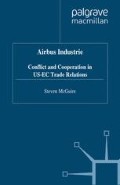Abstract
It was during this three year period that the dispute came as close as it ever did to causing a rift in American-European Community relations. The Airbus consortium had launched three aircraft programmes (A300, A310 and A320) in relatively quick succession and was now planning to undertake another. It was doing this without any clear indication that the existing programmes were making any money for the consortium. American anger at this development was intense. To compound matters, for the first time in the dispute, the proposed Airbus aircraft threatened the viability of a new US project, the MDC MD-11.
Access this chapter
Tax calculation will be finalised at checkout
Purchases are for personal use only
Preview
Unable to display preview. Download preview PDF.
Notes
That the ill-fated L-1011 is widely regarded as one of the best designed airliners ever only underscores the importance of developing products within a broader marketing strategy. Advanced technology alone does not guarantee sales. Lockheed’s technical prowess is well documented. An accessible discussion can be found in: John Newhouse, The Sporty Game, New York: Alfred A. Knopf, 1982, esp. ch.5.
One study operates on the premise that Boeing captures 40–50 per cent of any market it enters. Even since 1982, when Airbus was a direct competitor to Boeing, this assumption has held true. Thomas Doleys, The Political Economy of Strategic Trade: Airbus and the International Trade in Commercial Aircraft, MA Thesis, Department of Government: University of Virginia, 1992, p. 54, note 75.
I. M. Destler, American Trade Politics, 2nd edn, Washington: Institute for International Economics and the Twentieth Century Fund, 1992, pp. 123–4.
Elias Krauss, ‘US-Japan negotiations on construction and semiconductors, 1985–1988: building friction and relation-chips’, in, Peter Evans et al., Double-Edged Diplomacy: International Bargaining and Domestic Politics, Berkeley: University of California Press, 1993, p. 274.
Ian McIntyre, Dogfight: The Transatlantic Battle Over Airbus, Westport CT: Praeger, 1992, p. 165.
Keith Hayward, ‘Airbus: twenty years of European collaboration’, International Affairs, 64(1), Winter 1987/88, p. 16.
Interview with former USTR official, Washington, November 1993. See also, Steven Dryden, Trade Warriors: USTR and the American Crusade for Free Trade, Oxford: Oxford University Press, 1995, ch.16.
Anastasia Pardalis, ‘European political co-operation and the United States’, Journal of Common Market Studies, 25 (4), June 1987, pp. 288–9.
Author information
Authors and Affiliations
Copyright information
© 1997 Steven McGuire
About this chapter
Cite this chapter
McGuire, S. (1997). The Height of Acrimony, 1985–88. In: Airbus Industrie. St Antony’s Series. Palgrave Macmillan, London. https://doi.org/10.1057/9780230372214_7
Download citation
DOI: https://doi.org/10.1057/9780230372214_7
Publisher Name: Palgrave Macmillan, London
Print ISBN: 978-1-349-40085-0
Online ISBN: 978-0-230-37221-4
eBook Packages: Palgrave Political & Intern. Studies CollectionPolitical Science and International Studies (R0)

